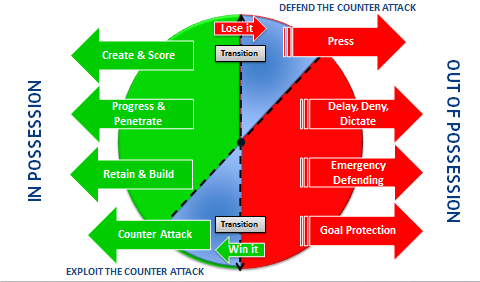In Possession - Introduction / Principles of Play
"Without the ball, you can't win" - Johan Cruyff
If you attend any FA course, you will hear the phrase "principles of play" referenced frequently. When we have the ball, the core principles of play are going to be different from when we don't have the ball and in between we have the transition periods, when we've either just lost possession or just won the ball back.
What do the FA mean by "Principles of Play"? These are core concepts of how the FA want our English teams to play and the FA provide the below diagram, which summarises their principles of play in line with the England DNA. This diagram is used on the current FA courses as a starting point for discussing the principles of play and you may find this link useful too in terms of referencing some of these ideas for different age groups.

In this section we're interested in the green area - "In Possession". We've covered the "Out of Possession" principles of play elsewhere and we'll reference the transition periods in both sections.
Below is a bit more information on each of the key points...
Retain & Build
Retain very simply means keeping hold of the ball. Let's encourage our players not to give the ball away cheaply, to be comfortable in possession and to want the ball rather than being scared of receiving it for fear of making a mistake.
A lot of young players will have the habit of trying to win the game for their team every time they get the ball with one amazing dribble, pass or shot. Yes - we want them to be creative and try things, but helping them understand when the right time to do this is vs when to keep possession and build, in the interests of creating a better option for that creative "killer" moment is a key long term concept.
Can we shift the ball around quickly as a team to pull the opposition out of shape and give us space to then progress / penetrate into? How might we do this? Can we use the width and depth of the pitch to create space and movement off the ball / communication to create options for the player on the ball? Worth getting your players thinking about these sorts of concepts.
Progress & Penetrate
The above "retain & build" phase leads naturally to the idea that when the right moment arises, we can progress through the pitch and penetrate the opposition with the hope of creating a goalscoring chance. This will invariably require good movement from your players to pull defenders away and create space, combined with creative solutions from the player on the ball.
Can your team use the full width and depth of the pitch to create space and options? Can they combine quickly with team mates to unlock a defence? Can they try something individually that might lead to a goalscoring chance for themselves or a team mate? How might this look in central areas, wide areas, on the counter attack? Lots of questions to encourage your players to think about.
Create & Score
The progression up the pitch and the penetration we've talked about above is ultimately leading to (hopefully) scoring a goal. Can we encourage our players to be confident in front of goal and look for creative solutions to the problems they'll be posed by their opponents? Can we look individually and collectively at ways of creating and scoring goals from different areas of the pitch? Scoring goals is great fun - it's not usually something young players have any problem being enthusiastic about, so practices designed around goalscoring will often be their favourite part of training.
And if our players end up in a situation where their options to progress, create or score are blocked by good opposition defensive play, we can recycle back to "Retain and Build" and go again.
Transition - Exploit the Counter Attack
We've just won the ball back, so our players are going from a defensive mindset, where their positioning is likely to be geared towards stopping the opposition playing effectively, to an attacking mindset. A narrow, compact defensive unit suddenly has to try and turn into an expansive, attacking unit.
The great thing is that the opposition are also in transition, so how successful you are in these moments largely comes down to who reacts most effectively and quickest.
A transition can happen anywhere on the pitch. If the opposition have pushed up the pitch and lost the ball, can we exploit the space they have left behind with quick counter attacking play? How might this look? If we win the ball high up the pitch from an opponent trying to play out, how do we exploit that situation? From a midfielder surging forward? From a full back who has overlapped and lost possession?
There are lots of ways in which your team may find itself winning the ball back and then in transition, but key will be the speed of thought of your players to exploit the situation and an awareness of where the space is. If your team think and act more quickly than your opponent, they have a great chance of using the transition phase effectively.
Useful References: